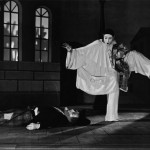For me, 2002 will be most remembered for the Actors Theatre’s production of Angels in America, which I saw while visiting Phoenix in October and which only qualifies for a mention here because if Mike Nichols’s rumored seven hour adaptation of the plays captures even half of the magic and the joy of Tony Kushner’s language then it will surely be the best film I see in 2003. I spent the rest of the year, though, here in Knoxville, TN with its two screens devoted to interesting fare, leaving me grossly ill-equipped to make sweeping generalizations about the year in movies. (Ask me again in ten months.) Instead, here are some impressions of the 2002 film experiences that still linger.
The only film that I watched three days in a row, more enraptured by it each time, was Tsai Ming-liang’s What Time Is It There? The magic of the film for me is found in Lu Yi-ching’s performance. In this remarkable woman, a widow experiencing the mysteries of mourning and loss, Tsai has offered a counterargument to all who would summarily dismiss his films as simply Antonioni-like laments of alienation. What Time was also the most beautiful film I saw all year, featuring brilliant camera work from Benoît Delhomme.
My favorite sequence from any film was buried in the middle of Paul Thomas Anderson’s Punch-Drunk Love. Adam Sandler’s Barry Egan stands before his dream woman, Emily Watson, while the rest of his world collapses around him. A screaming telephone harasses him, a forklift crashes, and the voices of his coworkers conspire in a cacophony of fits and shrieks. I actually laughed out loud during the scene, partly as a temporary reprieve from the tension, partly out of sheer admiration for Anderson’s gifts. Punch-Drunk Love earns my “outstanding sound design” award for 2002. Hitchcock would have loved it.
The most consistently entertaining film I saw was Roger Moore’s Bowling for Columbine, which manages to be both provocative and surprisingly even-handed. Setting out to discover why we Americans are so good at shooting each other, Moore finally offers few concrete answers but succeeds in undercutting the most commonly held misconceptions, by conservatives and liberals alike. Moore still struggles occasionally to balance his earnest concern with parody, but the film makes a quality statement. Bowling is worth seeing for its interview with Charlton Heston alone—the most cringe-inducing moment in a film littered with cringe-inducing moments.
The film experience that I most cherish from this year was getting to sit beside my parents for a screening of Dreyer’s Passion of Joan of Arc, which was sponsored by the Maryland Hall for the Creative Arts and accompanied by the Annapolis Chorale’s performance of Richard Einhorn’s Voices of Light. My parents had never seen Passion, or anything like it. Their silence as we walked through the hushed crowd toward our car is testament, I think, to the sublime majesty of Dreyer’s film.
And finally, a short list of films that I saw for the first time in 2002 and that made me a better man for it: Au Hasard Balthazar (Bresson), La Promesse (Dardenne), Through a Glass Darkly (Bergman), Good Men, Good Women (Hou), Waking Life (Linklater), The Children of Paradise (Carne), and Dancer in the Dark (Von Trier).
